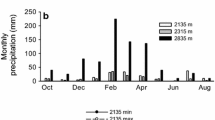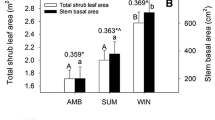Summary
Predawn xylem pressure potentials were measured on two California chaparral shrubs, Ceanothus megacarpus and Ceanothus crassifolius, throughout the winter and spring growing season and into the summer drought. On the days xylem pressure potentials were measured, leaf orientation measurements were made on a population of marked leaves from the same shrubs. Predawn xylem pressure potentials decreased from -0.1 MPa in both species to -7.8 and -6.6 MPa in C. megacarpus and C. crassifolius, respectively, between May and August, 1981. Leaf inclinations became more vertical during this period with the greatest change observed in C. crassifolius. This change in leaf inclination was reversible, and, in the late winter and early spring, one year old leaves became more horizontal. Leaf azimuths were random and did not change seasonally. Simulations of solar radiation interception indicated that the increase in leaf inclination associated with summer drought reduced the absorption of solar radiation in August by 6% for C. megacarpus and 20% for C. crassifolius. Standard leaf energy budget calculations suggest that steep leaf inclinations would result in slightly lower leaf temperatures and transpiration rates under summer conditions.
Similar content being viewed by others
References
Anderson MC, Denmead OT (1969) Short wave radiation on inclined surfaces in model plant communities. Agron J 61:867–872
Duncan WG (1971) Leaf angle, leaf area, and canopy photosynthesis. Crop Science 11:482–485
Ehleringer JR (1981) Leaf absorptances of Mohave and Sonoran Desert plants. Oecologia 49:366–370
Ehleringer JR (1982) The influence of water stress and temperature on leaf pubescence in Encelia farinosa. Amer J Bot 69:670–675
Ford ED, Newbould PJ (1971) The leaf canopy of a coppiced deciduous woodland. J Ecol 59:843–862
Gates DM (1980) Biophysical Ecology. Springer-Verlag, New York, p 611
Gill DS, Mahall BE (1978) A quantitative comparison of phenological patterns of two chaparral shrubs of the Santa Ynez Mountains. Bull Eco Soc Amer 59:108
Hanes TL (1981) California chaparral. In: di Castri F, Goodall DN, Specht RL (eds) Ecosystems of the World vol 11. Mediterranean-type Shrublands. Elsevier Scientific Publishing Co, New York, pp 139–174
Medina E, Sobrado M, Herrera R (1978) Significance of leaf orientation for leaf temperature in an Amozonian sclerophyll vegetation. Rad Envir Biophys 15(2):131–140
Miller PC (1967) Leaf temperatures, leaf orientation and energy exchange in Quaking Aspen (Populus tremuloides) and Gambell's Oak (Quercus gambellii) in central Colorado. Oecol Plant 2:241–270
Miller PC, Poole DK (1979) Patterns of water use by shrubs in southern California. For Sci 25:84–98
Miller PC, Stoner A (1979) Canopy Structure and environmental interactions. In: Solbrig OT, Jain S, Johnson GB, Raven P (eds) Topics in Plant Population Biology. Columbia University Press, New York, pp 428–458
Monsi M, Saeki T (1965) Über den Lichtfaktor in den Pflanzengesellschaften und seine Bedeutung für die Stoffproduktion. Jap J Bot 14:22–52
Montenegro G, Aljaro ME, Kummerow J (1979) Growth dynamics of Chilean matorral shrubs. Bot Gaz 140:114–119
Mooney HA (1981) Primary production in Mediterranean-climate regions. In: di Castri F, Goodall DN, Specht RL (eds) Ecosystems of the World, vol 11. Mediterranean-type Shrublands. Elsevier Scientific Publishing Co, New York, pp 249–255
Mooney HA, Dunn EL (1970a) Photosynthetic systems of Mediterranean-climate shrubs and trees of California and chile. Amer Nat 104:447–453
Mooney HA, Dunn EL (1970b) Convergent evolution of Mediterranean-climate evergreen sclerophyll shrubs. Evolution 24:292–303
Mooney HA, Gulmon SL, Parsons DJ, Harrison AT (1974) Morphological changes within the chaparral vegetation type as related to elevational gradients. Madroño 22:1118–1128
Mooney HA, Harrison AT, Morrow PA (1975) Environmental limitations of photosynthesis on a California evergreen shrub. Oecologia (Berlin) 19:293–301
Mooney HA, Ehleringer J, Björkman O (1977) The energy balance of leaves of the evergreen desert shrub Atriplex hymenelytra. Oecologia (Berlin) 29:301–310
Poole DK, Miller PC (1975) Water relations of selected species of chaparral and coastal sage communities. Ecology 56:1118–1128
Schlesinger WH, Gill DS (1980) Biomass, production, and changes in the availability of light, water, and nutrients during the development of pure stands of the chaparral shrub, Ceanothus megacarpus after fire. Ecology 6:781–789
Shaver GR (1978) Leaf angle and light absorbtion of Arctostaphylos species along environmental gradients. Madroño 25:133–139
Werk KS, Ehleringer J (1984) Non-random leaf orientation in Lactuca serriola. Plant Cell Environ 7:81–87
Author information
Authors and Affiliations
Rights and permissions
About this article
Cite this article
Comstock, J.P., Mahall, B.E. Drought and changes in leaf orientation for two California chaparral shrubs: Ceanothus megacarpus and Ceanothus crassifolius . Oecologia 65, 531–535 (1985). https://doi.org/10.1007/BF00379668
Received:
Issue Date:
DOI: https://doi.org/10.1007/BF00379668




